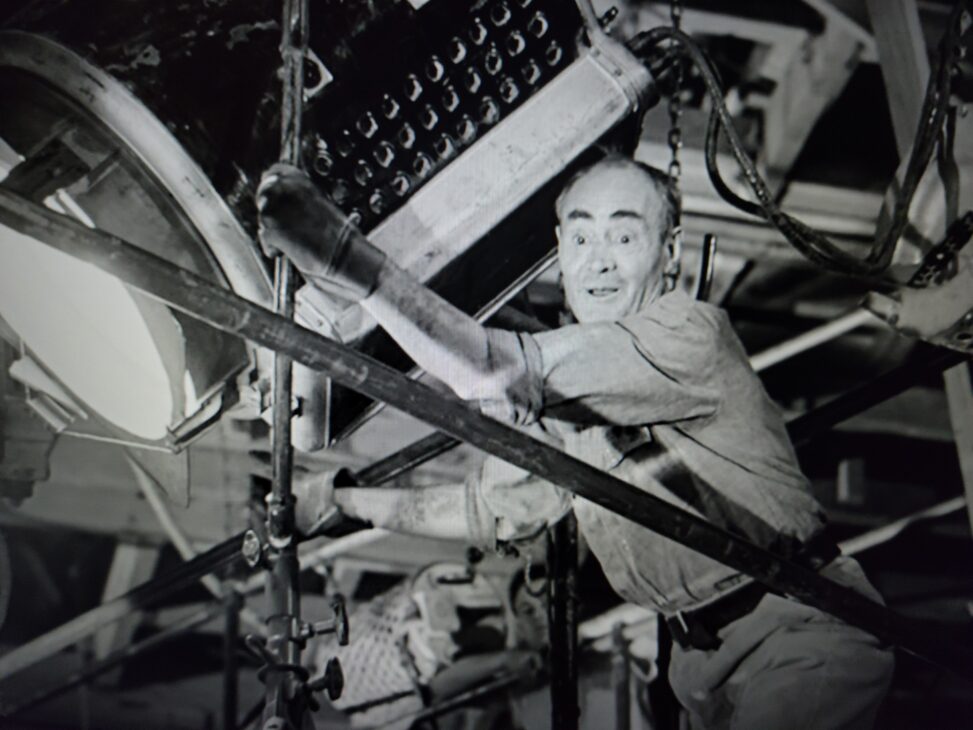In the 1950 film, Sunset Boulevard, estranged movie star Norma Desmond returns to her old studio in hopes of reliving her years of fame where a light technician referred to as Hog-Eye recognized her and shines the spotlight on her. While Hog-Eye is only seen for a brief moment and speaks minimal lines, he plays a key role in progressing Norma’s delusion, singling her out from the rest of the crowd. In the “Small Players, Small Parts Dossier”, Robert J. Read uses a specific example from another film to talk about the “crisscrossing careers and faces in the scene,” and how the “space in which [the] scene unfolds encourages us to think metaphorically of this and other scenes as cultural repositories” (Read 121). While Read’s analysis is centred on a scene from a different film, his statement can be applied to Hog-Eye’s scene in Sunset Boulevard. The crisscrossing of careers, a light technician and a formerly famous actress, reinstates Norma’s position as someone who is not as relevant as she once was. Hog-Eye recognizes Norma and appears wide-eyed and enthusiastic while addressing her while she responds unenthusiastically. In reality, he is the one who still works in the film industry while she does not. Norma’s tone while addressing Hog-Eye represents how she interprets her relevance compared to others. While the scene is filled with extras portraying studio employees, producers, and actors/actresses, the lighting technician is the one who brings Norma into the spotlight; nobody acknowledges her until this moment. Norma basks in the glory of the attention she gets from everyone around her, solidifying her delusion of still being the star she believes she is; however, the audience knows that this is not the case. When the director Cecil DeMille returns and sees how everyone has swarmed around Norma, he tells Hog-Eye to put the light back where it belongs. While we do not hear or see Hog-Eye after this command, the spotlight leaves Norma, representing how she is no longer in the limelight or relevant. Hog-Eye is an older male and is enthusiastic when he sees Norma because he recognizes her from the olden days. Hog-Eye acts as a prop because he manipulates the scene by shining the spotlight. In a time when silent films from the 1920s were out of date, it is culturally significant that Norma who was known for her roles in these silent films is singled out from the rest of the crowd: she does not belong. Although he is enthusiastic and acts out of familiarity, Hog-Eye inadvertently alienates Norma to the audience; he shines light on Norma’s current situation as someone who has fallen from stardom. This scene is pivotal in the film because it parallels the real-life culture shift in film during this time. Hog-Eye is the personification of the spotlight and his role as a minor character is to create this fleeting moment where Norma’s legacy is recognized rather than her current relevance; he ultimately turns the spotlight off of her for good.
Works Cited
Read, Robert J. “Uncredited: Jack Mulhall and the Decline of Stardom.” Screen, vol. 52, issue 1, 1 January 2011, pp. 114-120, https://doi.org/10.1093/screen/hjr001.
Sunset Boulevard. Directed by Billy Wilder, Performances by William Holden, Gloria Swanson, Eric Von Stroheim, and Nancy Olson, Paramount, 1950. YouTube, https://www.youtube.com/watch?v=fRObt8mE3kY&t=4513s.

Provide Feedback